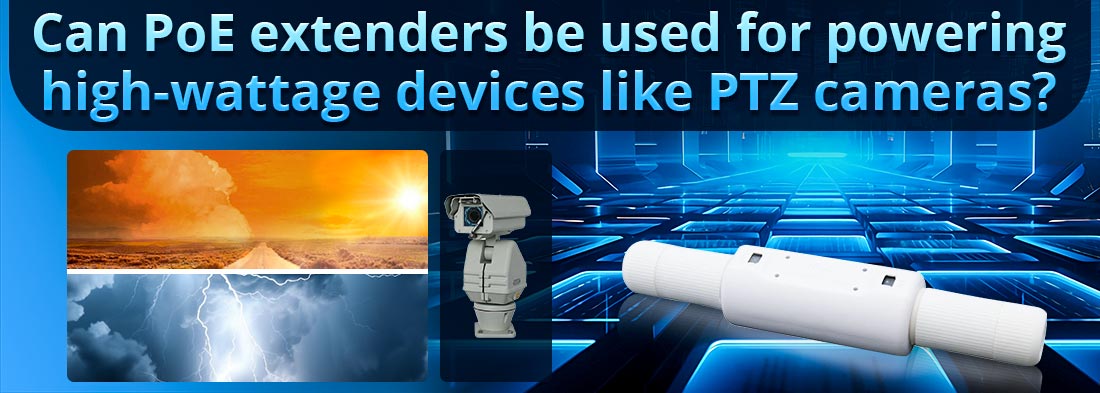
Sí, los extensores PoE (alimentación a través de Ethernet) se pueden utilizar para alimentar dispositivos de alta potencia como cámaras PTZ (panorámica, inclinación y zoom), pero hay varios factores a considerar para garantizar la compatibilidad y el rendimiento confiable. Los dispositivos de alto voltaje, como las cámaras PTZ con calentadores incorporados o iluminadores infrarrojos (IR), a menudo requieren más energía que los dispositivos PoE estándar, lo que puede plantear desafíos para el suministro de energía en distancias extendidas.
Consideraciones clave para el uso de extensores PoE con dispositivos de alta potencia
1. Compatibilidad estándar PoE
Los dispositivos de alta potencia normalmente requieren PoE+ (802.3at) o PoE++ (802.3bt) estándares para una entrega de energía adecuada:
--- 802.3af (PoE): Suministra hasta 15,4W, insuficiente para la mayoría de las cámaras PTZ con funciones avanzadas.
--- 802.3at (PoE+): Suministra hasta 30W, adecuado para muchas cámaras PTZ sin accesorios adicionales.
--- 802.3bt (PoE++): suministra hasta 60 W (Tipo 3) o 100 W (Tipo 4), necesarios para cámaras PTZ de alta potencia con calentadores, limpiaparabrisas o LED IR de alta potencia.
Asegúrese de que el extensor PoE admita el estándar requerido. Muchos extensores PoE modernos están diseñados para funcionar con PoE+ o PoE++ para lograr compatibilidad con dispositivos de alta potencia.
2. Presupuesto de energía
--- Los extensores PoE extraen energía del interruptor o inyector PoE principal y la reinyectan al dispositivo conectado. Cada extensor de la cadena consume una parte del presupuesto de energía disponible, dejando menos para el dispositivo terminal.
--- Para dispositivos de alto voltaje, el presupuesto de energía disponible en el extremo del dispositivo debe cumplir o exceder los requisitos del dispositivo:
--- Verifique la capacidad de alimentación de paso del extensor para asegurarse de que pueda entregar suficiente energía después de tener en cuenta las pérdidas.
3. Distancia y pérdida de energía
--- El cableado Ethernet estándar introduce pérdida de energía en largas distancias, lo que puede reducir la cantidad de energía disponible en el punto final.
--- Muchos extensores PoE pueden operar hasta 100 metros (328 pies) por unidad. Para distancias más largas, se pueden conectar en cadena varios extensores, pero esto aumenta la pérdida de energía.
--- Utilice cables Cat5e o Cat6 de alta calidad para minimizar la pérdida de energía y mantener un voltaje suficiente.
3. Número de extensores en la cadena
--- Cada extensor de la cadena reduce aún más la energía disponible para el dispositivo terminal. Al alimentar dispositivos de alta potencia, es esencial limitar la cantidad de extensores en la cadena.
--- Algunos extensores permiten una entrada de energía adicional a través de un adaptador de energía local para mitigar las pérdidas y mantener una entrega de energía adecuada para dispositivos de alto voltaje.
4. Condiciones ambientales
Las cámaras PTZ suelen instalarse en exteriores o en entornos hostiles, lo que requiere extensores con características de nivel industrial:
--- Tolerancia de temperatura: asegúrese de que el extensor funcione dentro del rango de temperatura del entorno de instalación.
--- Protección de ingreso (IP): Las instalaciones al aire libre requieren extensores resistentes a la intemperie o resistentes.
5. Requisitos de ancho de banda
--- Las cámaras PTZ con transmisiones de video de alta definición (HD) o ultra alta definición (UHD) tienen altos requisitos de ancho de banda de datos.
--- Asegúrese de que el extensor PoE admita velocidades gigabit para manejar el tráfico de datos sin cuellos de botella.
Beneficios de utilizar extensores PoE para dispositivos de alta potencia
--- Despliegue de larga distancia: Extensores PoE permiten instalar cámaras PTZ lejos del conmutador o inyector PoE principal, lo que las hace adecuadas para estacionamientos, estadios y grandes sitios industriales.
--- Costos de infraestructura reducidos: elimina la necesidad de tomas de corriente adicionales o fuentes de alimentación locales cerca de la cámara.
--- Instalación simplificada: Un solo cable para alimentación y datos simplifica el cableado y reduce la complejidad de la instalación.
Desafíos y Soluciones
Insuficiencia de energía:
--- Solución: Utilice extensores o inyectores PoE++ para suministrar suficiente energía.
--- Si se requieren varios extensores, elija modelos que admitan entrada de energía auxiliar.
Pérdida de datos o latencia:
--- Solución: Utilice extensores con soporte Gigabit Ethernet y cableado de alta calidad.
Estrés ambiental:
--- Solución: seleccione extensores de grado industrial con clasificación IP65 o superior para entornos exteriores o hostiles.
Extensores PoE recomendados para dispositivos de alta potencia
--- Extensor TRENDnet Gigabit PoE++: Admite 802.3bt y ofrece hasta 60 W, adecuado para cámaras PTZ con altas necesidades de energía.
--- Netgear PoE++ Extender: ofrece entrega de energía sólida y velocidades gigabit, diseñado para implementaciones de nivel empresarial.
--- Adaptador PoE de Ubiquiti Networks: Compatible con PoE+ y PoE++, ideal para cámaras PTZ de gran ancho de banda.
Conclusión
Los extensores PoE se pueden utilizar eficazmente para alimentar dispositivos de alta potencia como cámaras PTZ, siempre que cumplan con los requisitos ambientales, de ancho de banda y de energía de la aplicación. Para obtener un rendimiento confiable, seleccione extensores compatibles con los estándares PoE necesarios (802.3at o 802.3bt), garantice un presupuesto de energía suficiente en el punto final y utilice cableado de alta calidad para minimizar las pérdidas. Con una planificación adecuada, los extensores PoE proporcionan una solución rentable y escalable para alimentar dispositivos de alta potencia a largas distancias.